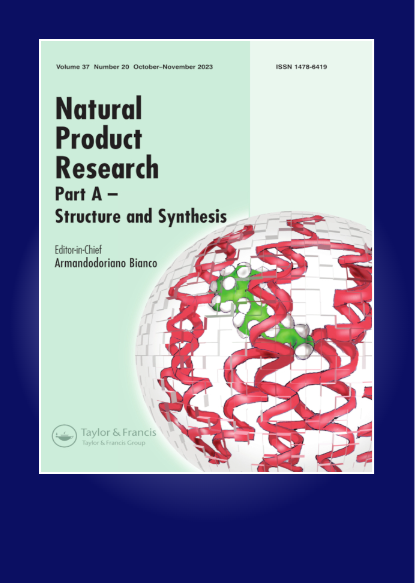用于制备阿育吠陀疗法中治疗伤口的药用精油 "Pinda 油 "的一种植物--Decalepis hamiltonii 中的体外细胞迁移促进成分。
IF 1.9
3区 化学
Q3 CHEMISTRY, APPLIED
引用次数: 0
摘要
Decalepis hamiltonii, Wight & Arn. (Apocyanaceae) 是用于制备 "Pinda 油 "的原料之一,"Pinda 油 "是一种在阿育吠陀中用于治疗伤口的药用油。从用于制备 "Pinda 油 "的植物原料中提取的正己烷、二氯甲烷和乙酸乙酯提取物中,与阴性对照组(1% DMSO in DMEM,4.2 ± 1.2 和 100% DMEM,4.1 ± 0.9)相比,D. hamiltonii 的正己烷提取物在划痕伤口试验(SWA)中显示出最高的平均伤口闭合百分比(75.1 ± 2.9)。对哈密尔敦蕨属植物茎的己烷提取物进行分馏,分离出 2-羟基-4-甲氧基苯甲醛(1)和羽扇豆醇的长链酯混合物(2),它们在 SWA 中显示出增强的细胞迁移能力。据观察,在 SWA 过程中,羽扇豆醇酯与细胞膜结合和/或进入细胞。研究发现,这些成分也存在于 "平达油 "中,可能有助于增强 "平达油 "的伤口愈合活性。本文章由计算机程序翻译,如有差异,请以英文原文为准。
In-vitro cell migration enhancing constituents from Decalepis hamiltonii, a plant used in the preparation of ‘Pinda oil’, a medicinal oil used in Ayurveda for wound management
Decalepis hamiltonii, Wight & Arn. (Apocyanaceae) is a one of the raw materials used in the preparation of ‘Pinda oil’, a medicinal oil which is used for treatment of wounds in Ayurveda. Of the hexanes, dichloromethane, and ethyl acetate extracts derived from the plant raw materials used to prepare ‘Pinda oil’, the hexanes extract of D. hamiltonii exhibited the highest mean percentage wound closure (75.1 ± 2.9) compared to the negative controls (1% DMSO in DMEM, 4.2 ± 1.2 and 100% DMEM, 4.1 ± 0.9) in the scratch wound assay (SWA). Fractionation of the hexanes extract of stem of D. hamiltonii led to the isolation of 2-hydroxy-4-methoxybenzaldehyde (1) and a mixture of long chain esters of lupeol (2), which showed enhanced cell migration in SWA. It was observed that the esters of lupeol bind to the cell membrane and/or enter the cells during the SWA. It was found that these constituents are also present in ‘Pinda oil’ which may contribute to the enhancement of wound healing activity of ‘Pinda oil’.
求助全文
通过发布文献求助,成功后即可免费获取论文全文。
去求助
来源期刊

Natural Product Research
化学-医药化学
CiteScore
5.10
自引率
9.10%
发文量
605
审稿时长
2.1 months
期刊介绍:
The aim of Natural Product Research is to publish important contributions in the field of natural product chemistry. The journal covers all aspects of research in the chemistry and biochemistry of naturally occurring compounds.
The communications include coverage of work on natural substances of land and sea and of plants, microbes and animals. Discussions of structure elucidation, synthesis and experimental biosynthesis of natural products as well as developments of methods in these areas are welcomed in the journal. Finally, research papers in fields on the chemistry-biology boundary, eg. fermentation chemistry, plant tissue culture investigations etc., are accepted into the journal.
Natural Product Research issues will be subtitled either ""Part A - Synthesis and Structure"" or ""Part B - Bioactive Natural Products"". for details on this , see the forthcoming articles section.
All manuscript submissions are subject to initial appraisal by the Editor, and, if found suitable for further consideration, to peer review by independent, anonymous expert referees. All peer review is single blind and submission is online via ScholarOne Manuscripts.
 求助内容:
求助内容: 应助结果提醒方式:
应助结果提醒方式:


